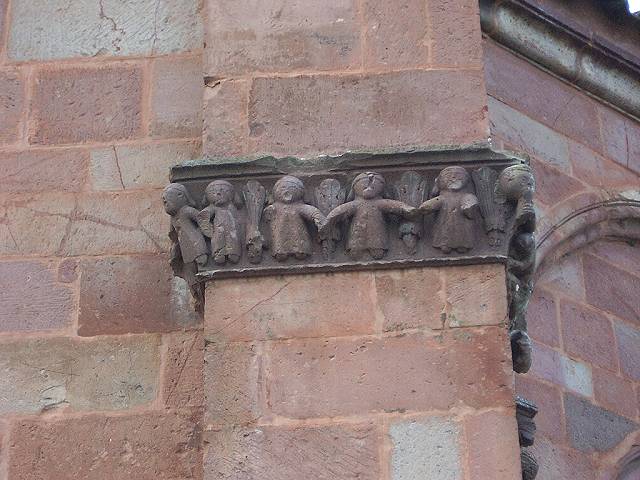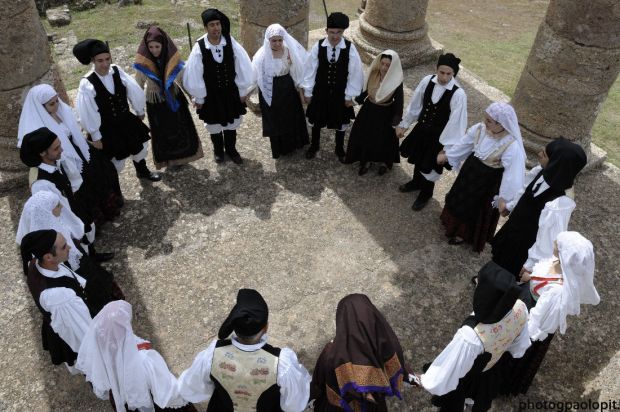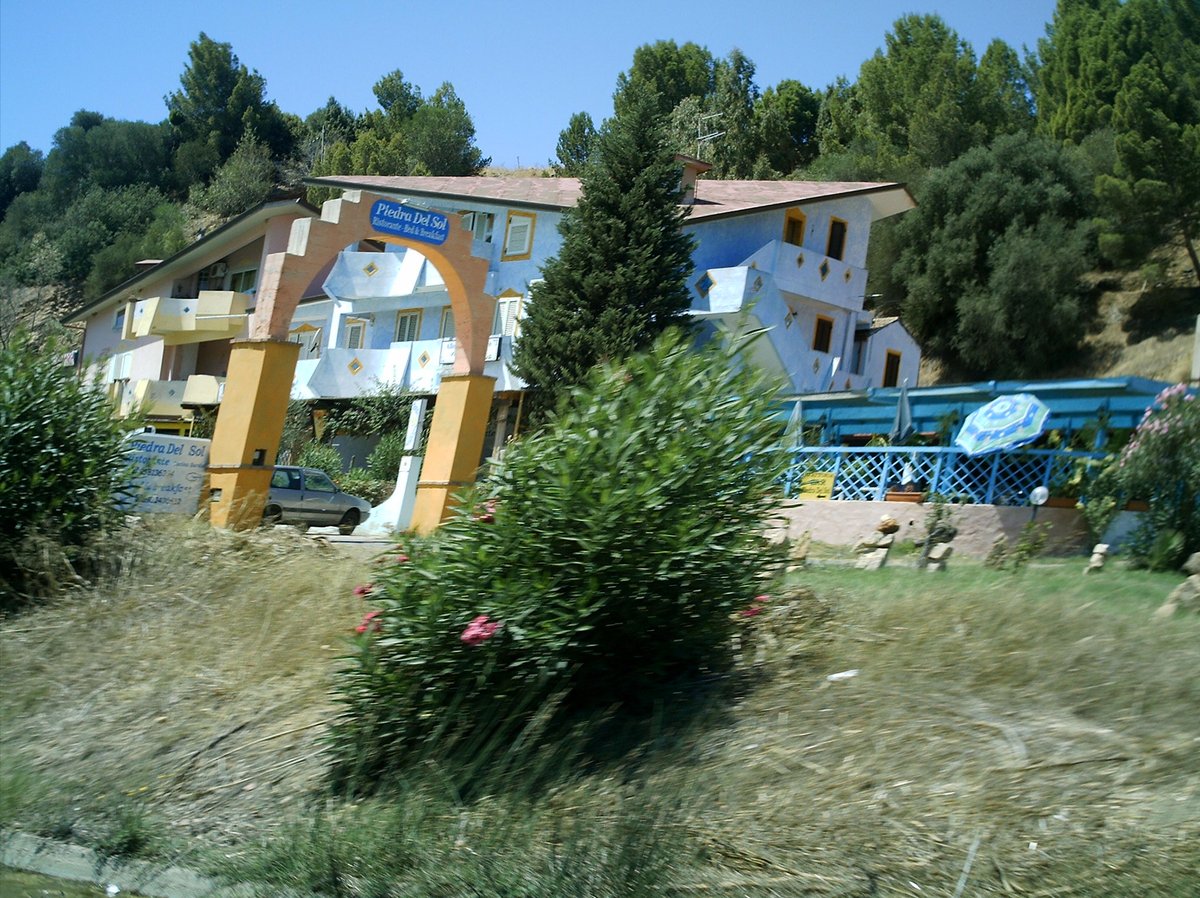
**BALLU SARDU: the Sardinian dances**
Thread about traditional Sardinian dances. #folklore #folkdance
#Sardinia
📸 Painting showing ballu tundu, XIX century
Thread about traditional Sardinian dances. #folklore #folkdance
#Sardinia
📸 Painting showing ballu tundu, XIX century

As you can imagine by now, Sardinian dances vary from place to place, just like dresses, language and traditions. They have though some common characteristics.
It's not known for certain the origin of the most ancient Sardinian dance (the ballu tundu), but people see archaic -
It's not known for certain the origin of the most ancient Sardinian dance (the ballu tundu), but people see archaic -

-influences in the circular shape and sacredness of the dance, recalling ancient tribal dances around the fire.
There are several depictions that academics link to the ballu tundu: the very first comes from a dish found in Monte d'Accoddi (a Prenuragic altar), where figures-
There are several depictions that academics link to the ballu tundu: the very first comes from a dish found in Monte d'Accoddi (a Prenuragic altar), where figures-

-are represented as dancing our traditional dances. The others come from Middle Age, where in several occasions there are sculptures of people dancing in church.
The link to churches is important because it explains the religious background of the tradition
📸San Pietro di Zuri
The link to churches is important because it explains the religious background of the tradition
📸San Pietro di Zuri

Ballu tundu was in fact danced outside (or inside, in earlier times) churches during festivals, as a continuous link of the sacred dance to religion. The ballu tundu was also danced around a fire or a player, bringing the mind back to tribal dances around fires. 

The dance is so sacred that it was often woven into fabrics.
Now, there are different kinds of dances and the dances evolved in time too. Sardinian dances have always been described as serious and methodic; the point wasn't to have fun but to comply a ritual.
Now, there are different kinds of dances and the dances evolved in time too. Sardinian dances have always been described as serious and methodic; the point wasn't to have fun but to comply a ritual.

People wouldn't smile but would carry on the dance even for 2 hours straight. The rhythmic movements hint at some kind of healing or apotropaic ritual. The dance was a serious thing, with rules even to just enter the dance or how to hold hands. Breaking these rules could 

-mean causing great offence and risking homicide.
The very basic of Sardinian dance is keeping the upper part of the body still, with a slight rocking, and use entirely the feet. People could take each other by hand or under the arm, according to the dance. The ballu tundu-
The very basic of Sardinian dance is keeping the upper part of the body still, with a slight rocking, and use entirely the feet. People could take each other by hand or under the arm, according to the dance. The ballu tundu-

-requires people to move in circle but there are variations in line or in couple too. Some dances don't require a male-female couple but can be danced by people of the same sex.
An important function of village dances was forming new couples. Some dances have a more
📸 Busachi
An important function of village dances was forming new couples. Some dances have a more
📸 Busachi

-important courting meaning, requiring men to show off more difficult steps.
So, what are some of these dances? Ballu tundu is likely the most ancient, with the group circling in little steps in clockwise direction.
📸 Gruppo folk Fluminimaggiore, Oristano

So, what are some of these dances? Ballu tundu is likely the most ancient, with the group circling in little steps in clockwise direction.
📸 Gruppo folk Fluminimaggiore, Oristano


The dance can start in line and then the leading couple will close the circle.
Passu torrau is originally from Mamoiada and it consists of a movement in which feet are barely risen from the ground but go ahead and back. It's a movement now used in different regions
📸 Mamoiada
Passu torrau is originally from Mamoiada and it consists of a movement in which feet are barely risen from the ground but go ahead and back. It's a movement now used in different regions
📸 Mamoiada

-especially in serious dances in circle.
Su dillu (or dilluru/dilliri) is instead a very joyful dance that also gave rise to the dance of s'argia. It's typical of inner Sardinia.
Some dances include small bows or jumps.
📸 Siligo, Ollolai

Su dillu (or dilluru/dilliri) is instead a very joyful dance that also gave rise to the dance of s'argia. It's typical of inner Sardinia.
Some dances include small bows or jumps.
📸 Siligo, Ollolai


Another dance is that of s'istella, in which the components recreate the shape of a star.
A Campidanese variation is that of sa sciampitta (last picture), in which a man is held upside down and he keeps dancing. It's thought to derive from an old Sardinian fight in which-


A Campidanese variation is that of sa sciampitta (last picture), in which a man is held upside down and he keeps dancing. It's thought to derive from an old Sardinian fight in which-



-people used to kick each other 😂
In some dances, like in this from Nuoro ⬇️, each couple can detach from the group and make a solo dance, spinning in circle.
There are also dances of a man with two women who spin around each other, or dances with S shapes.
In some dances, like in this from Nuoro ⬇️, each couple can detach from the group and make a solo dance, spinning in circle.
There are also dances of a man with two women who spin around each other, or dances with S shapes.

In the Sulcis-Iglesiente and Cagliari there is also another variation where people just go ahead and back in little steps. In the Sulcis, this is called ballu meurredinu and it's typical of festivals in squares, where space was limited.
📸 Tempio, Oliena, Gavoi, Desulo



📸 Tempio, Oliena, Gavoi, Desulo




Traditional dances are still practiced at every religious event, but are also spectacularised for every folklorist event. Still, this allows me to post several videos below 😂 

➡️ Gruppo folk Ortobene Nuoro.
Seriu zirau:
Su dillu:
Seriu zirau:
Su dillu:
➡️ Gruppo folk Murales Orgosolo.
Passu torrau:
Passu torrau:
➡️ Gruppo folk Ittiri Cannedu, Ittiri.
Dansa Ittiresa:
Dansa Ittiresa:
➡️ Gruppo folk Dorgali.
Ballu 'e iskina:
Ballu 'e iskina:
➡️ Gruppo folk Pro Loco Gavoi.
Dillaru:
Dillaru:
➡️ Gruppo folk Pro Loco Samugheo.
S'Orrosciada:
S'Orrosciada:
➡️ Associazione culturale Sant'Andrea, Gonnesa.
Ballu meurredinu:
Ballu meurredinu:
➡️ Gruppo folk Su Idanu, Quartu Sant'Elena.
Campidanese:
➡️ Gruppo folk San Gemiliano, Sestu.
Sciampitta:
Campidanese:
➡️ Gruppo folk San Gemiliano, Sestu.
Sciampitta:
➡️ Gruppo folk Quartiere Villanova, Cagliari.
Sa sciampitta:
Sa sciampitta:
• • •
Missing some Tweet in this thread? You can try to
force a refresh

















